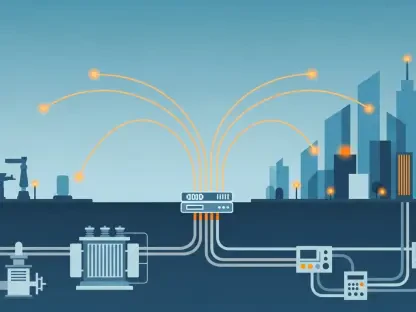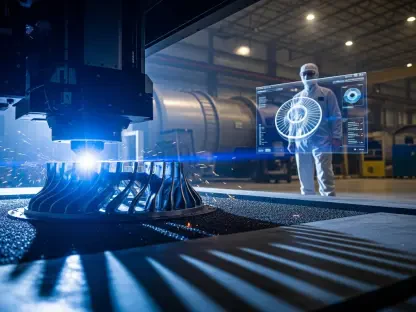The semiconductor industry stands at a crossroads, confronted by an array of challenges that are reshaping its landscape. Tariffs, trade restrictions, and shortages of skilled labor are among the significant factors influencing this critical sector. As global demand surges, the industry’s ability to adapt and innovate will determine its trajectory in the coming years. The stakes are high, with geopolitical tensions and technological advancements adding layers of complexity to an already intricate global supply chain. Companies must strategize effectively to navigate these challenges while maintaining a competitive edge.
Tariffs and Trade Challenges
The Economic Impact of U.S.-China Tariffs
The imposition of tariffs by the United States on Chinese imports has had a profound effect on the semiconductor industry. In 2024, the U.S. imported $139 billion worth of semiconductors and related components, indicating the significance of this trade partnership. However, tariffs have disrupted this flow, leading to increased costs for original equipment manufacturers, contract manufacturers, and electronics manufacturing services providers. The financial burden posed by these tariffs is exacerbated by underlying trade tensions between the two economic powerhouses. As tariffs are designed to incentivize domestic investment, they have inadvertently highlighted the inadequacies within the U.S. semiconductor production capacity.
While tariffs aim to bolster U.S. manufacturing, the repercussions are immediate and multifaceted. The short-term impacts include increased operational costs for manufacturers dependent on stable imports. This has strained industries such as aerospace and defense, which rely heavily on consistent legacy component supplies. Compounded by supply chain disruptions, these challenges have resulted in noticeable delays in both production and distribution. Furthermore, the reliance on offshoring over the years has left domestic manufacturing unable to swiftly expand capacity to meet demand without significant internal restructuring.
Geopolitical Implications and Industry Adaptations
Geopolitical tensions surrounding global semiconductor trade contribute further complexity to an already challenging situation. These dynamics influence inventory levels and pricing strategies for components, affecting sectors that demand high reliability, such as automotive and healthcare. The semiconductor industry finds itself needing to adjust quickly to maintain resilience in international markets. Companies must adopt agile strategies to counteract the rapid shifts in global trade patterns. Advanced analytics and AI tools have become indispensable in managing these uncertainties, allowing firms to optimize their supply chains amid volatile conditions.
The need for collaboration has become more urgent as companies grapple with geopolitical instability. Increased partnerships across international borders can help distribute risk more evenly along the supply chain. This collaborative approach could prove crucial for the semiconductor industry, which relies on diverse geographical sources for raw materials and manufacturing expertise. It is essential for companies to engage in proactive forecasting and risk assessment to navigate these geopolitical minefields. By leveraging comprehensive data analytics tools, firms are better positioned to anticipate trade disruptions and prepare alternative sourcing strategies.
Labor Shortages and Workforce Development
Overcoming the Shortage of Skilled Workers
A critical shortage of skilled labor poses another significant challenge to the semiconductor industry’s growth and sustainability. The demand for engineers and technicians continues to outpace supply, with projections indicating a need to fill over 160,000 positions by 2029. Government efforts to stimulate U.S.-based operations have intensified this demand, compounded by a rapidly aging workforce. With around 55 percent of current semiconductor employees over the age of 45, the industry is potentially facing a substantial talent gap. This shortage threatens to undermine the progress made in expanding domestic production capabilities.
To mitigate these labor shortages, companies are investing in long-term workforce development strategies, often in partnership with educational institutions. Programs focused on upskilling are becoming more prevalent as the industry seeks to cultivate a new generation of skilled workers. For instance, universities like Purdue are tailoring educational pathways with input from industry stakeholders to ensure graduates are equipped with relevant skills. However, these efforts require time to mature, and there remains an immediate gap that must be bridged. Artificial intelligence offers a potential solution for managing tasks that can be automated, thereby freeing up human resources for more complex roles.
The Role of Artificial Intelligence in Workforce Optimization
Artificial intelligence is increasingly being explored as a tool to address the shortfall in skilled labor. AI technologies can automate routine tasks, allowing existing employees to focus on more sophisticated engineering and problem-solving roles. Additionally, AI can aid in knowledge retention and dissemination, providing new entrants with valuable insights and training opportunities. By documenting processes comprehensively and making this information accessible, institutions can create a repository of expertise that serves current and future generations. AI-driven platforms can facilitate seamless transitions for new workforce entrants, providing support as they integrate into specialized roles.
Emerging technology’s potential in training and development is vast. AI-based educational tools can simulate real-world scenarios, enabling trainees to practice and refine their skills in a controlled environment. By facilitating continuous learning and adaptation, these technologies can help bridge the skills gap and ensure the industry remains resilient in the face of evolving challenges. As AI’s integration into the workforce deepens, it is crucial for companies to balance its use with the development of human talent, ensuring harmonious collaboration between human expertise and machine intelligence.
Supply Chain Resilience and Innovation
Managing Obsolescence through Predictive Analytics
The semiconductor supply chain faces increased risks of obsolescence as rapid innovation accelerates the lifecycle of components. In 2023 alone, approximately 474,000 parts reached their end-of-life, posing significant challenges for manufacturers to maintain adequate inventories. The combined forces of market consolidation and geopolitical instability have heightened the instances of sudden obsolescence, rendering traditional procurement strategies inadequate. Industries dependent on high-reliability components must now incorporate proactive measures to anticipate these changes and adjust their inventory management accordingly.
Advanced analytics and AI-driven tools offer invaluable solutions to manage the lifecycle of semiconductor components. By employing methods like data mining, predictive modeling, and machine learning, manufacturers can process real-time data alongside historical trends to anticipate obsolescence patterns. These tools enable companies to forecast customer demand accurately and adapt their procurement strategies to mitigate supply chain disruptions. Emphasizing resilience, this strategic shift allows the industry to maintain necessary component availability and minimize the impact of obsolescence on production timelines.
Building Sustainable Supply Chain Models
Sustaining the semiconductor industry’s growth amid rampant technological advancements requires a comprehensive approach to supply chain management. Transitioning from just-in-time strategies to more flexible models that accommodate volatility is crucial. By integrating predictive analytics into their operational frameworks, companies can achieve more precise forecasting of component needs, reducing the risk of supply interruptions. Furthermore, collaboration within the industry—from suppliers to end consumers—fosters a shared commitment to addressing risks collectively.
As companies enhance their supply chain resilience, they can harness insights from predictive tools to optimize their inventory levels and prepare for potential disruptions. Shifting to a more proactive approach entails a willingness to invest in innovative technologies and foster cross-sector collaboration. As the semiconductor sector evolves, prioritizing flexibility, collaboration, and innovation will be key to overcoming longstanding challenges and steering the industry toward a sustainable future.
Embracing Change for a Sustainable Future
The semiconductor industry finds itself at a pivotal juncture, facing numerous challenges that are reshaping its future. Factors such as tariffs, trade restrictions, and a shortage of skilled labor are significantly impacting this vital sector. As the global demand for semiconductors continues to grow, the industry’s ability to adapt and innovate will be crucial in determining its path forward. Currently, there’s immense pressure from geopolitical tensions and swift technological breakthroughs, further complicating the complex web of the global supply chain. To remain competitive, companies must develop robust strategies that allow them to successfully navigate these hurdles. This involves not only enhancing production efficiency but also securing supply chains and fostering talent development. The industry’s future depends heavily on its ability to balance these factors, remain agile, and push technological boundaries while mitigating risks associated with international politics and workforce shortages.









